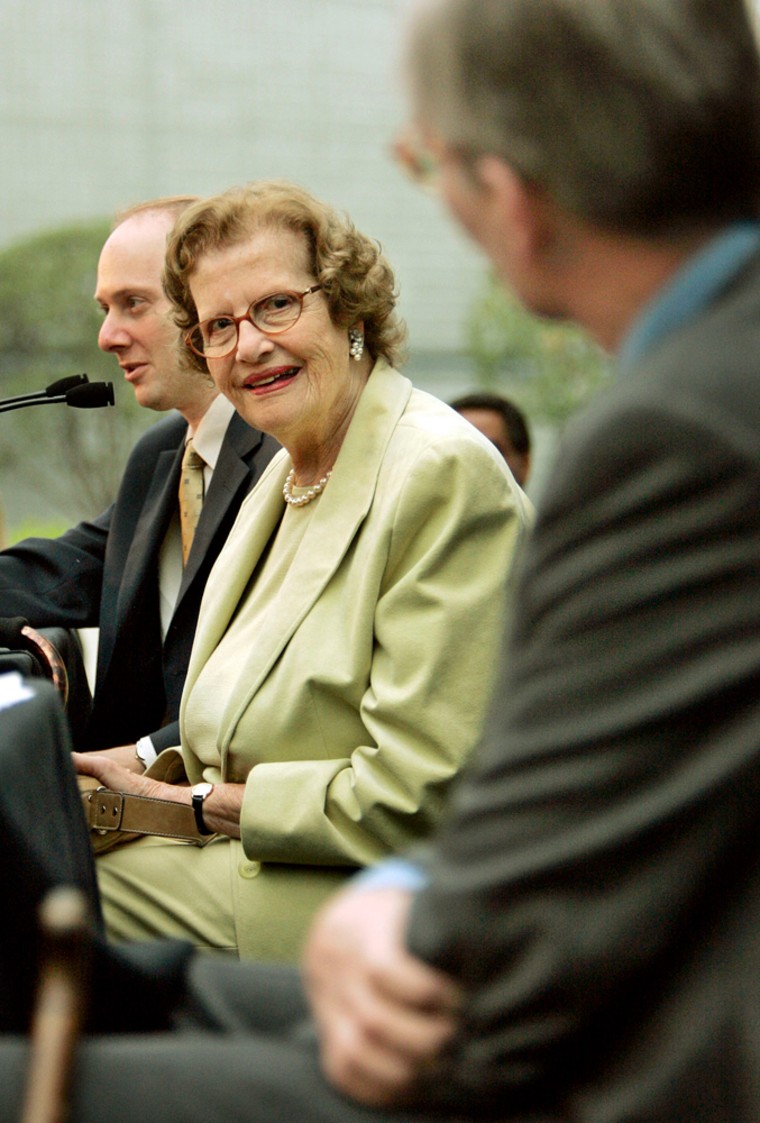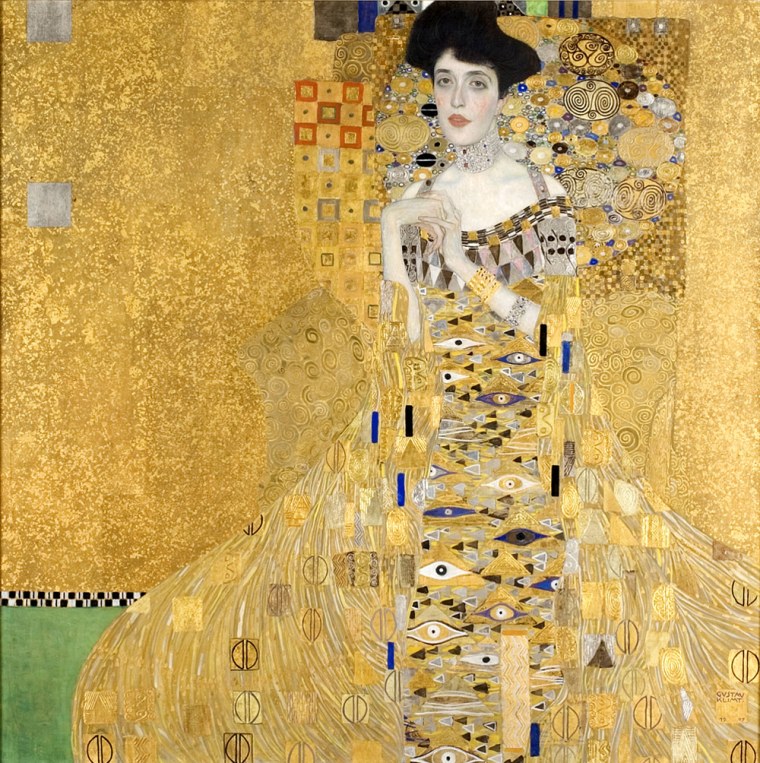Who is this woman so beautiful and haughty in her golden garments worthy of any red carpet?
She is Adele Bloch-Bauer, and her sumptuous portrait is the centerpiece of a special exhibit, "Gustav Klimt: Five paintings from the collection of Ferdinand and Adele Bloch-Bauer," on display at the Los Angeles County Museum of Art (LACMA) for the next three months.
The story of the Bloch-Bauers and how the Klimt masterpieces, seized by the Nazis after Germany annexed Austria in 1938, came to Los Angeles is a complex saga of wartime loss and post-war perseverance.
And for Adele Bloch-Bauer's niece, 90-year-old Los Angeles resident Maria Altmann, the recovery of the art after more than 60 years is a reunion of sorts. "I grew up with those paintings,” said Altmann. “They were hanging in my uncle's house."
Golden days
In the early 20th century the Bloch-Bauers, Altmann’s aunt and uncle, were prominent members of Vienna’s cultured and wealthy Jewish elite.
Ferdinand Bloch-Bauer, an industrialist and art patron, had a mansion in Vienna and a castle near Prague. Pointing to a photograph of Adele, Altmann remembers her as someone who "just loved to learn and study... . If she were around today she would have had a career in politics, or would have gotten a Ph.D.”

Instead, given the social constraints of the era, Adele hosted a "salon" where famous writers, musicians and artists met regularly to engage in spirited discussions at a time when Vienna was a key cultural center.
As part of this scene, the Bloch-Bauers were generous patrons of Gustav Klimt, widely considered one of the great figures of early 20th century painting, who embodied the height of Viennese art at the time.
"He painted dazzling portraits of Vienna's society women,” said Stephanie Barron, LACMA’s Curator.
One of Klimt’s best known works, Barron said, is “his 1907 magnificent ‘Portrait of Adele Bloch-Bauer I’ ... an example of his groundbreaking ‘gold style’ with sumptuous gold patterning reminiscent of Byzantine mosaics.”
In addition to the "gold" portrait, Ferdinand Bloch-Bauer commissioned and owned the four other Klimts that are currently on display at LACMA.
In 1925, tragedy struck: Adele died of meningitis. Two years earlier in her will she asked her husband to donate the Klimts to the Austrian Art Gallery in Vienna upon his death.
At the time he noted that this was not binding, but that he would abide by her request. In the meantime, Altmann noted, her uncle created a kind of shrine to his late wife at his mansion, where he had "beautiful flowers and the five paintings."
Nazi seizure
As Altmann looked at old photographs, she recalled a privileged upbringing, which included a governess, vacations in the Tyrol, trips to Paris and a debutante party at the Vienna Opera House.
It was a charmed life that would be changed forever by war.
When Nazi Germany annexed Austria in 1938, a wave of anti-Semitism was unleashed. Ferdinand Bloch-Bauer escaped to neighboring Switzerland, leaving behind most of his property, including the Klimt paintings. They were immediately confiscated.
"They stole those paintings from my uncle,” Altmann said emphatically. "Trucks drove up in front of my uncle's house and robbed him of all his possessions."
At the same time, Altmann, just 22 at the time, had to face the horror of having her husband, Fritz Altmann, arrested by the Nazis and sent to the Dachau concentration camp. However, with help from her brother-in-law, she managed to free her husband and they both fled first to England, and then to the United States. The couple eventually made their way to Los Angeles, where they made a new life with their four children.
As the war ended, Ferdinand Bloch-Bauer died in Zurich, Switzerland, almost penniless. In his last will, which revoked all previous ones, he left all his possessions to the three children of his brother. This was Altmann and her brother and sister; he had no children of his own.
Meanwhile in Austria, a Nazi attorney had liquidated Bloch-Bauer’s holdings, giving the "gold" portrait and other Klimts to the Austrian Gallery in Vienna. In fact, the "Heil Hitler" slogan appears above the lawyer’s signature on the 1941 documents.
Again, times change
After the war, Ferdinand Bloch-Bauer’s heirs attempted to recover their stolen possessions. They made some progress, but the Klimts were considered untouchable because the government claimed that Adele bequeathed the paintings to Austria in her 1923 will.
The situation remained unchanged for years — until 1998, when Hubertus Czernin, an Austrian journalist, wrote a series of articles disputing the Austrian claim to the Klimts.
Altmann, as the only surviving heir of the Bloch-Bauers, decided to sue to recover the paintings. Her attorney, Randol Schoenberg, is also the grandson of famous Jewish Viennese composers Arnold Schoenberg and Eric Zeisl. And, like Altmann, his family had fled Vienna during the war andsought refuge in Los Angeles.
In 2000 Schoenberg began a long legal battle on Altmann’s behalf that went all the way to the U.S. Supreme Court. Eventually, in 2004, he won the right to sue Austria.
But with Altmann not far from her 10th decade, Schoenberg agreed to enter into binding arbitration in Austria rather than pursue another lengthy lawsuit. "It was a huge gamble," said Schoenberg. “But it paid off."
The panel of three Austrian judges decided in January of this year that the paintings belonged to Altmann and the descendants of her siblings, not to the Austrian Gallery.
Dream come true
“It was a wish come true, said Altmann. “I could not imagine that three Austrian arbitrators would be so fabulously just.”
At the exhibit opening, Altmann, standing next to the gold portrait of her aunt, glowed as she accepted congratulations and gave many interviews. Allowing for the temporary exhibition of the paintings at the LACMA, she said, was her way of saying thanks to the city that welcomed her when she fled the Nazis.
As for what will be the final destination of the Klimts once the temporary exhibition ends on June 30, Altmann says that is still to be decided in conjunction with the other heirs. She says she would prefer that they go to a museum so the public can continue to enjoy the masterpieces.
Auction houses, meanwhile, are salivating at the prospect of representing the Bloch-Bauer heirs — paintings of this quality hardly ever go on the market and some experts estimate the value of the five Klimts at $300 million.
